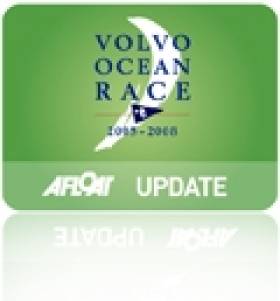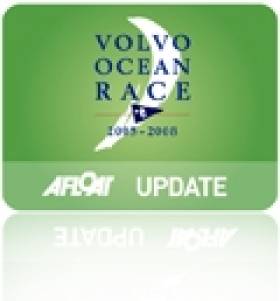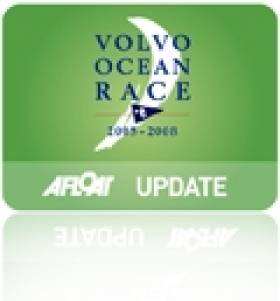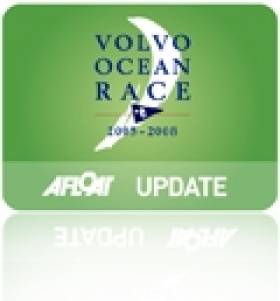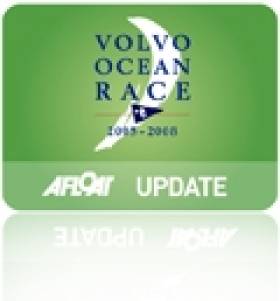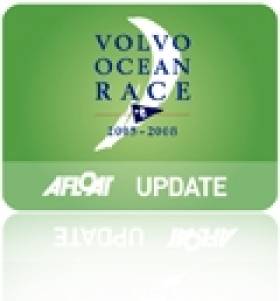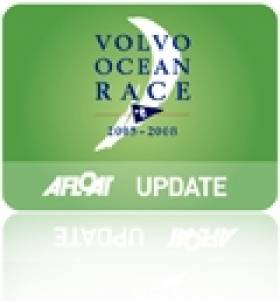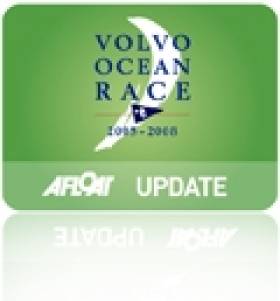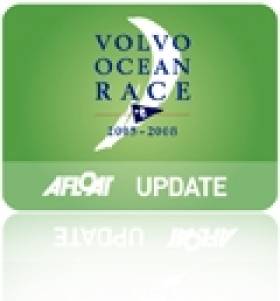Displaying items by tag: Team Vestas Wind
Volvo Ocean Race Teams To Square Off In Genoa Later This Month
#VOR - Volvo Ocean Race rivals Team SCA and Team Vestas Wind will go head-to-head once more in a series of pro-am races at the Genoa Boat Show from September 30 to October 5.
The six pro-am races will give the race’s many Italian fans the first chance to see VOR boats on home waters and provide an intriguing challenge for the crews of Team Vestas Wind and Team SCA, which will be named at a later date.
The teams will be matched in two daily pro-am in-port races on 30 September 30, 1 and 2 October before they join a Genoa Boat Show fleet race on Saturday 3 October.
Team Vestas Wind skipper Chris Nicholson, whose Danish-backed challengers memorably bounced back from near disaster in the second leg last November when the boat was grounded on a reef in the Indian Ocean – recorded on the spot by the boat's Irish onboard reporter Brian Carlin – was very much looking forward to taking on Team SCA’s all-women crew again.
“The last time we were in Genoa, we were on our way to Persico Marine to repair our Volvo Ocean 65, so it’s very special to be able to be back in Italy racing our boat,” said Nicholson.
“The Vestas Wind is in great condition and the team still has much more to give, as fans saw when we returned ahead of Leg 8 of the Volvo Ocean Race in Lisbon. I’m proud to represent Vestas at the Genoa Boat Show and look forward to competing against Team SCA once more,” he continued.
After the race finished in Gothenburg on 27 June, the blue boat sailed via its home port of Copenhagen to Race HQ in Alicante, Spain for routine maintenance. It will depart for Genoa the weekend before the Genoa Boat Show starts on 30 September.
They will face stiff competition in Genoa from Team SCA, who finished third overall in the In-Port Race Series of the Volvo Ocean Race and then beat event rivals Dongfeng Race Team in the Artemis Challenge during Cowes Week last month. They impressed too during the Fastnet Race, also held during the traditional sailing festival on the Isle of Wight.
Anton Albertoni, president of the Genoa Boat Show’s organizing body I Saloni Nautici, said he was delighted to welcome the two crews to Genoa.
“The Volvo Ocean Race brings the pinnacle of offshore racing to the Genoa Boat Show,” he said. “For the show's visitors, though, this is not an invitation to dare but to meet those men and women who have made the sea their passion, their lifestyle, their daily pleasure.
"Those who face such challenges have the ocean at heart and having them in Genoa represents a true celebration of the sea. That's why we are very happy to welcome the women from Team SCA and the men from Team Vestas Wind.
“Moreover, the Volvo Ocean 65s have been built and fitted with some of the best Italian marine technology and the Genoa Boat Show is all about Made in Italy.”
Team SCA squad member Carolijn Brouwer added: “It was great to have the team back together again for the Fastnet Race, and we were happy with our performance.
"We look forward to once again locking horns with Team Vestas Wind, and meeting many of our Italian supporters at the Genoa Boat Show."
#VOR - Team Vestas Wind have passed their biggest test yet in their quest to rejoin the Volvo Ocean Race in time for the eighth leg from Lisbon to Lorient.
As Jonno Turner writes for the official VOR website, crowds lined the waterfront at the Lisbon Race Village yesterday (Saturday 30 May) to see the team take their rebuilt yacht on the water for the first time since running aground in the Indian Ocean last November.
“It’s a massive hurdle to have overcome. It’s something we don’t have to think back to anymore, it’s about enjoying the future," said shore manager Neil Cox.
And what that future holds is shaking up what's been a highly competitive six-boat race since the start of the year. Here's looking forward to Irish journalist Brian Carlin's onboard reports.
#VOR - Team Vestas Wind aren't quite ready to rejoin the Volvo Ocean Race after their mishap in the Indian Ocean last November.
But their name loomed large over yesterday's (Saturday 18 April) in-port race at Itajaí, sailed in far-too-calm conditions that tested the six competing yachts to the limit.
As the official VOR website reports, Team Brunel claimed top honours in what was an "excruciatingly but fascinatingly drawn-out" race.
The win also puts them ahead of the field in the overall standings – but only by one point on closest rivals Abu Dhabi Ocean Racing, who were first to cross the line into the Brazilian port on 5 April.
MAPFRE – who were docked two points last Thursday (16 April) by the ISAF-appointed independent duty for repairs against the rules during Leg 5 – were the first to catch what little wind there was to be had, after an all-nighter to shore up their weakened mast.
Abu Dhabi, meanwhile, duelled with the women of Team SCA, who have been strong in this race's in-port battles. However, a penalty for fouling Team Brunel put paid to the ladies' efforts.
The final showdown was between Abu Dhabi, the Chinese contingent Dongfeng Race Team and the Dutch boat of Team Brunel – and it was to be the latter that pipped the trio at the post.
As for the absent Team Vestas Wind? Progress is being made at their Italian shipyard, with skipper Chris Nicholson saying that "90% of the parts are together".
That's not the same as having a finished boat that's ready to race, of course, as "you’ve got to remind yourself just how complex these boats are, the amount of hydraulics and ropes that goes on – it’s all happening as we speak," he told the VOR website in Itajaí.
But Nicholson is confident that, should plans continue as they are, the team will get "three days on the water before racing" when the fleet assembles in Lisbon for the penultimate leg.
Team Vestas Wind Was 'Unaware Of Any Navigational Danger' Before Grounding Says Report
#VOR - Team Vestas Wind "was unaware of any navigational danger, in its vicinity, incorrectly assessed the minimum chart depth at Cargados Carajos Shoals to be 40 metres and understood that it was safe to sail across the shoals."
That's how the panel conducting the independent report into the grounding of the Danish team's yacht in the Indian Ocean on the second leg of the Volvo Ocean Race summed up the situation that led to the incident.
As the official VOR website reports, the results of the investigation were published today (Monday 9 March) and were based on data recorded at the time of the grounding plus interviews with the crew, race management and other parties.
Despite navigator Wouter Verbraak stepping down from the team earlier this year, the investigative panel – comprising Rear Admiral (Rtd) Chris Oxenbould (chair), Stan Honey and Chuck Hawley – did not single out any individuals for blame, but did note that there were "deficiencies in the use of electronic charts and other navigational data" on board the vessel, currently under repairs in Italy with plans to rejoin the race for the final leg this summer.
There were also "deficiencies in the cartography presenting the navigational dangers on the small and medium scales of the chart system in use."
However, the report said the team's emergency management in response to the grounding "worked well and there were no administrative or race management issues that contributed to the incident."
The VOR website has much more on the story HERE.
Team Vestas Wind Arrives In Bergamo Ahead Of Repairs
#VOR - As Dongfeng Race team celebrate their home-port victory in the third leg of the Volvo Ocean Race from Abu Dhabi to Sanya, the grounded Team Vestas Wind are half a world away in the foothills of the Italian Alps.
Following the team's pledge earlier this month to rejoin the race before the final leg out of Lisbon this summer, the boat has completed its long journey from the Southern Indian Ocean to the Persico Marine yard near Bergamo in Italy.
That's where the damage sustained in November's devastating grounding on shoals between Madagascar and Mauritius will be assessed before the repair works begin - with only a tight four-month window to get back on the ocean.
Sail-World brings us this photo gallery compiled by the team's onboard reporter – and regular Afloat contributor – Brian Carlin charting the boat's road trip from Genoa to Bergamo, where the whole team will pitch in to get the one-design VOR 65 ship-shape once more.
One man who won't be joining them, however, is Wouter Verbraak, who last week was officially removed as navigator on the team. His replacement has yet to be named.
Team Vestas Wind to Change Navigator for Volvo Ocean Race
#teamvestas – Team Vestas Wind today announced that navigator Wouter Verbraak is no longer a member of the crew for the Volvo Ocean Race.
The Dutchman was on board when the team was run aground on November 29 during Leg 2 on a reef in the middle of the Indian Ocean, causing major damage.
In the same announcement, Team Vestas Wind also stated that the remaining members of the crew would continue helping the team with the boat repair process at Persico's boatyard in Italy before their planned return to the race in June for the final two legs from Lisbon under skipper Chris Nicholson.
A statement issued early on Friday said: "Chris Nicholson has completed his review, together with the lead sponsor Vestas and sub-sponsor Powerhouse, and the decision has been made that Wouter Verbraak will no longer continue as navigator of the Vestas Wind.
"Team Vestas Wind will be joined by a new navigator in time for the Lisbon stopover and Leg 8 start in June. Team Vestas Wind would like to thank Wouter for his service and wish him well in the future."
Verbraak, in a statement, added: "I am very sad to announce that I have been notified that I will not continue with Team Vestas Wind.
"I respect Chris Nicholson's decision and wish the team the very, very best of luck with the hard work ahead of them in the Volvo Ocean Race. I would have wanted to help the team getting back in the race again and contribute to their success in the last parts of the race.
"On a personal note I am looking forward to the new sailing challenges that are coming up for me in the months ahead and want to keep sharing the passion that I have for this great sport with you all.
"Someone recently told me: 'Life is not about how many breaths you take, but about the moments that take your breath away'. I am looking forward to the new breathless moments to come. Ocean racing tends to offer many of them."
The remaining shore and sailing crew will continue to work as integral members of Team Vestas Wind, and will use their skills to assist Persico in the boat repair process.
They will also support the team at stopovers before Lisbon to keep Team Vestas Wind at the centre of race activities. The crew were grounded on a reef near St Brandon archipelago in the Indian Ocean. The boat was badly damaged but was retrieved just before Christmas.
It is expected to arrive on a Maersk Line ship in Genoa, Italy on Sunday and then be transported with the help of race sponsors GAC Pindar to Persico's boatyard in Bergamo for the rebuild to start in earnest.
Team Vestas Wind Pledge To Rejoin Volvo Ocean Race
#VOR - The grounded Team Vestas Wind have declared their intention to rejoin the Volvo Ocean Race at some point before the final leg out of Lisbon this summer.
Team chief executive Morten Abaek and skipper Chris Nicholson made the announcement at last night's VOR Life at the Extreme awards in Abu Dhabi as the rest of the fleet prepared for today's first in-port race ahead of the third leg to Sanya in China.
According to The Wall Street Journal, the team's boat – which surprised the sailing world when it ran aground on shoals in the Indian Ocean between Madagascar and Mauritius in late November – is in better condition than expected, and plans are in motion for rebuilding and repair works at an Italian shipyard.
Though the beleaguered team will have no chance of topping the table if they do get their boat back in the race, it would be a testament to their spirit if they indeed can get the show back on the seas.
“This gives us the opportunity to perform one of the biggest comebacks in sailing and prove to the world who we are,” said Albaek.
And Ireland's own Brian Carlin, as the team's on-board reporter, will surely be there to document every step along the way.
The Wall Street Journal has more on the story HERE.
Team Vestas Wind Get Their Yacht Off The Rocks
#VOR - Team Vestas Wind have successfully lifted their VOR 65 from the Indian Ocean reef where it grounded three weeks ago during the second leg of the 2014-15 Volvo Ocean Race.
The vessel is badly damaged, but still in one piece – "not bad for a boat which ran into the reef in St brandon at 19 knots," writes Jonno Turner for the official VOR website.
As previously reported on Afloat.ie, the complicated retrieval operation was overseen by team skipper Chris Nicholson, who last week flew in to Mauritius, some 400km away from the remote reef, to discuss plans with team shore chief Neil Cox.
“We were able to get the boat across the lagoon this morning [21 December] on the high tides, and it went well enough that we could pull it straight out of the lagoon," said Cox of the three-hour operation.
He added that the "beyond delicate" job could not have been achieved without the help of the local work force assisting in re-anchoring the boat and carrying oxygen bottles needed for cutting off the keel.
The vessel is now being shipped to Malaysia before transport back to Europe, as VOR chiefs set up an independent report into the grounding incident. The team, meanwhile, is exploring its options for the remainder of the round-the-world yachting challenge.
The VOR website has much more on the story HERE.
Team Vestas Wind's Nicholson Returns to the Scene of The Grind
#vor – Team Vestas Wind skipper Chris Nicholson (AUS) has flown back to a remote Indian Ocean reef to help oversee a complicated operation to retrieve his stranded boat after it was grounded there during Leg 2 of the Volvo Ocean Race nearly three weeks ago.
The 45-year-old flew in to Mauritius last night (December 17) to join the team's shore chief Neil Cox, a fellow Australian, who is leading the process.
Cox is one of the most experienced men in the business but the challenge to free the stricken Volvo Ocean 65 vessel from the grip of the reef in the Cargados Carajos Shoals (St Brandon), is a new one, even for him.
It has been there since the afternoon of November 29, when the boat ran on to the rocks at around 19 knots (35 kph), and forced Nicholson and the eight other men on board to abandon ship. The skipper eventually led his crew to safety.
"The ultimate plan, the gold-medal prize we're reaching for, is to get the boat buoyant enough to float across the lagoon to get it into more protected water," Cox told www.volvooceanrace.com.
"That would stop it disintegrating out on the reef, and, at the same time, once we get to the other side of the reef, gives us the chance to set it up in a controlled fashion to either be able to tow the boat back to Mauritius, or to use the derrick of the Maersk Line ship coming here on Monday to get it on board."
'Bizarre scenarios'
Cox, who has worked with Nicholson on two previous Volvo Ocean Race campaigns, added: "The race has taken me through some pretty bizarre scenarios, but I would say that this one is unique."
Nicholson and Cox set up the recovery operation in the Mauritian capital of Port Louis, liaising with local resources, chartering a boat they will use as a mother ship, getting all the necessary tools through customs and the permits to go back to the archipelago 430km away where the boat lies.
"We'll base ourselves on this mother ship, on the inside of the lagoon. It's on the leeward side of the reef and two and half miles away from the boat. The ship has the facilities for us to live onboard, because there is no way for us to stay on the island. We've also chartered local fishing boats to cross the lagoon everyday.
"It's a case of how structurally sound the boat is, and what we can utilise to get it buoyant again. And anything that floats, float tanks, buoyancy bags, you name it, is coming out with us."
He continued: "We want to bring as much of the boat back as possible. If anything can be recycled or used for a potential new boat, we have to do everything in our power to make that happen.
"The reality is, it's a very dangerous workplace we're going to. It doesn't have all the nice things we have in the stopovers. It's in the middle of the ocean. We're on our own. And, while I'd avoid the cheap shark headlines, yes, there is a lot more activity (of sharks) on the reef at nighttime."
Cox has seen much in his career but the saga still continues to astound him.
"Every now and then I feel like I'll wake up and it'll all just be a crazy dream, and I'd say, "wahoo, wasn't that the worst dream I've had in a long while?'"
Team Vestas Wind Explores Options After VOR Write-Off
#VOR - Disaster-struck Team Vestas Wind is "exploring the opportunity" of re-joining the Volvo Ocean Race a week after coming a cropper on an Indian Ocean reef, as Jonno Turner reports on the official race website.
The news comes days after Ireland's own Brian Carlin, the on-board reporter for the ill-fated team, gave his personal account of what went down on their VOR 65 in a video blog post.
At a press call in Abu Dhabi, host city of the next race stopover, team chief executive Morten Albæk said "we'll do everything within our means" to get the crew racing again.
But with the crashed boat a write-off, the next best option is building a new boat.
"Whether that can be done, and done in a time which is meaningful for Team Vestas Wind to re-enter the race, is still to be concluded," he said.
It's still a mystery as to exactly how Team Vestas Wind's heading put them in such close contact with the Cargados Carajos Shoals, a 50km-long reef northeast of Mauritius.
Team navigator Wouter Verbraak blamed their failure to "zoom in" on their electronic charts.
"Not doing so is the big mistake that I made," he said, "but the good thing is that we didn't make any more."



























